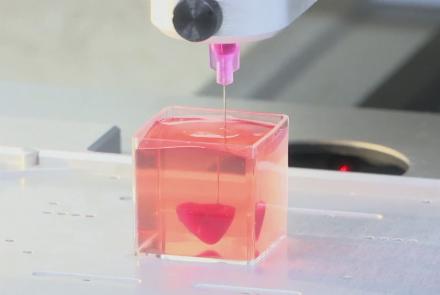It is hoped the small heart will pave the way for transplants without donors when every hospital might have access to 3D organ printers. It is a technological triumph - a 3D heart including, for the first time, cells, blood vessels, ventricles and chambers.
Produced by researchers at Tel Aviv University, the tiny heart is the size of a rabbit's, but is a scientific breakthrough.
Professor Tal Dvir of Tel Aviv University’s School of Molecular Cell Biology and Biotechnology says it's a proud moment.
“This is the first time that the whole cellular heart with blood vessels is printed. And another major breakthrough is that it is printed from the materials of the patient itself,” Dvir said.
Prof. Dvir says the unique process is based on a small biopsy taken from a patient.
“The cells are reprogrammed to become stem cells and then differentiated to become cardiac cells and cells that form blood vessels,” he says.
“And the biomaterial, the collagen and other sugars that are in the tissue is processed to become a bio-ink and together when mixed we have bio-inks for the heart and bio-inks for the blood vessels - and then we use a 3D printer to print whole hearts with the major blood vessels,” he added.
Now in its initial stages, the technology will be developed in the coming years in the hopes of creating organs for effective human transplants.
Nadav Noor, a doctoral student in Advanced Science, says it's a pivotal moment.
“There's still a lot of challenge that remains, it is going to take at least few years until we're going to reach a whole heart with functional, pumping heart,” he says. “I am not sure it’s going to serve ourselves in the next few years, but for our children, I think it’s going to be maybe an amazing opportunity. Especially for heart disease patients.”
Currently, it takes three hours to print one heart, which measures about 2.5 centimeters. In the coming years, hearts will be transplanted into small animals such as rats or rabbits for tests.
Prof. Chaim Lotan, Director of The Herat Institute at the Hadassah Medical Centre in Jerusalem says the 3D printed heart is an important step forward.
“We are still in a very early phase,” he says. “It will take some time to go from a small size heart into an entire big heart, it will be the challenges of seeing that we have enough blood supply to the heart, it will be a challenge to see that the heart is pumping, all cells and muscles are synchronized. So, we still have a long way to go, but we are very optimistic.”
The researchers hope that in ten years, every hospital will own printers to make tissues and organs that can be transplanted into patients.

